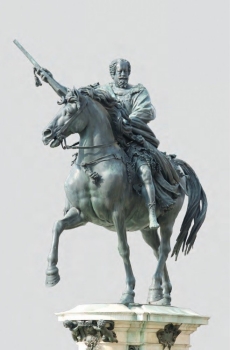In his still highly influential 1958 account of the development of seventeenth-century Italian sculpture, Rudolf Wittkower characterized the early works of the Tuscan sculptor Francesco Mochi (1580–1654) as “a fanfare raising sculpture from its slumber,” heralding the advent of the baroque. But, in Wittkower’s view, as Mochi’s career unfolded his innovations were eclipsed by the greater talent of his younger contemporary, Gianlorenzo Bernini (1598–1680), and the embittered older sculptor reverted to a severe form of mannerism in his later works. Against this interpretation Irving Lavin argued in 1970 that Mochi progressed unwaveringly throughout his career toward heightened spirituality and dematerialization, provocatively describing Mochi’s works as “the only sculptures produced in Rome after about 1625 which one could imagine would have looked no different had Bernini never been born.” Whether one casts Mochi as a Salieri to Bernini’s Mozart or as an isolated interpreter of an increasingly outmoded, austere form of spirituality—and all subsequent scholarship on Mochi has oscillated between these accounts—these characterizations each take for granted a history of baroque sculpture centered on Bernini, without probing the historical processes that led to the dominance of his art.
The book I am preparing takes Mochi’s sculptures as the entry point for an inquiry into the historical and cultural forces driving the transformation of sculpture at the beginning of the seventeenth century. Mochi’s distinctive art took form at the intersection of two cultural fault lines that profoundly shaped his career: the end of the dominance of the Florentine artistic tradition in Italy and the Catholic church’s explicit demands for a reformed yet highly affecting religious art in the wake of the Council of Trent. Mochi’s sole seventeenth-century biographer, Giovanni Battista Passeri, reported that the sculptor “always wanted to show himself a rigorous imitator of the Florentine manner.” Passeri also recorded that Mochi was very devout, and indeed Mochi devoted his career entirely to religious sculpture and portraiture. In my analysis, Mochi’s determination to carry forward a Florentine and Michelangelesque tradition, while reconciling it with new religious imperatives, produced a visible tension in his art that resulted in some of the most breathtaking sculptures of the century—though it ultimately fractured his career.
This irresolvable tension also renders peculiarly visible the new representational demands being placed upon sculpture, making Mochi’s works extraordinary documents of the lived negotiation of these historical changes. In sculptures such as his early Virgin Annunciate (1609) for Orvieto cathedral, for example, I found that Mochi undertook a systematic excavation of the Florentine tradition, reflecting upon Michelangelo, Donatello, and—more unexpectedly—the medieval Tuscan sculptor Giovanni Pisano, in whom he found a model for ways in which drapery could be newly mobilized to narrate and to enhance emotion. Throughout his career, I argue, Mochi self-consciously engaged and reinvented visual traditions in a startlingly ambitious fashion, from his interpretation of the ancient and Florentine motif of the running maiden (Aby Warburg’s “Nympha”) in his Saint Veronica (1629–1640) for Saint Peter’s, to his daring translation of medieval mosaics into colossal sculpture in his late Saint Peter and Saint Paul (c. 1640–c. 1650) for the early Christian basilica of San Paolo
My tenure at CASVA has been especially fruitful for my research on Mochi’s bronze equestrian monuments, erected in Piacenza to the reigning and former dukes, Ranuccio I (1569–1622) and Alessandro Farnese (1543–1592). Among later sixteenth- and seventeenth-century equestrian monuments, these sculptures are unusual in not having been commissioned by the sovereign but rather by the citizens of Piacenza, who I argue initiated the project as a strategic act of self-representation at a critical moment of political and social transition. The monuments are also unusual in appearance, and the sculptures’ distinctive features, in
Members' Research Report Archive
Francesco Mochi and the Edge of Tradition
Estelle Lingo, University of Washington, Seattle
Samuel H. Kress Senior Fellow, 2011–2012

Francesco Mochi, Equestrian Monument to Ranuccio | Farnese, 1612–1629, Piazza Cavalli, Piacenza. Author photograph
Unbelievable: Rethinking Caravaggio's Religious Art
Estelle Lingo, Andrew W. Mellon Professor, 2016 – 2018
Mochi's Edge and Bernini's Baroque, Caravaggio's Religious Art, and The Grand Tour from the Italian Perspective
Estelle Lingo, Andrew W. Mellon Professor, 2016 – 2018